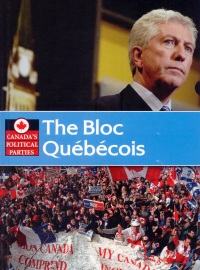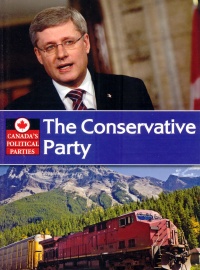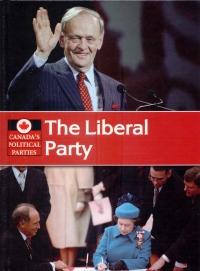| ________________
CM . . .
. Volume XVIII Number 21. . . .February 3, 2012 
 |
The Bloc Québécois. (Canada's Political Parties).
Douglas & Patricia Baldwin.
Calgary, AB: Weigl, 2012.
32 pp., pbk. & hc., $10.95 (pbk.), $24.95 (hc.).
ISBN 978-1-77071-699-5 (pbk.), ISBN 978-1-77071-694-0 (hc.).
Subject Heading:
Bloc Québécois.
Grades 6-8 / Ages 11-13.
Review by Gail Hamilton.
*** /4
|
| |
|
 |
The Conservative Party. (Canada's Political Parties).
Douglas & Patricia Baldwin.
Calgary, AB: Weigl, 2012.
32 pp., pbk. & hc., $10.95 (pbk.), $24.95 (hc.).
ISBN 978-1-77071-700-8 (pbk.), ISBN 978-1-77071-695-7 (hc.).
Subject Heading:
Conservative Party of Canada.
Grades 6-8 / Ages 11-13.
Review by Gail Hamilton.
*** /4
|
| |
|
 |
The Green Party. (Canada's Political Parties).
Gillian Poulter.
Calgary, AB: Weigl, 2012.
32 pp., pbk. & hc., $10.95 (pbk.), $24.95 (hc.).
ISBN 978-1-77071-701-5 (pbk.), ISBN 978-1-77071-696-4 (hc.).
Subject Heading:
Green Party of Canada.
Grades 6-8 / Ages 11-13.
Review by Gail Hamilton.
*** /4
|
| |
|
 |
The Liberal Party. (Canada's Political Parties).
Douglas & Patricia Baldwin.
Calgary, AB: Weigl, 2012.
32 pp., pbk. & hc., $10.95 (pbk.), $24.95 (hc.).
ISBN 978-1-77071-702-2 (pbk.), ISBN 978-1-77071-697-1 (hc.).
Subject Heading:
Liberal Party of Canada.
Grades 6-8 / Ages 11-13.
Review by Gail Hamilton.
*** /4
|
| |
|
 |
The New Democratic Party. (Canada's Political Parties).
Juanita Rossiter.
Calgary, AB: Weigl, 2012.
32 pp., pbk. & hc., $10.95 (pbk.), $24.95 (hc.).
ISBN 978-1-77071-703-9 (pbk.), ISBN 978-1-77071-698-8 (hc.).
Subject Heading:
New Democratic Party.
Grades 6-8 / Ages 11-13.
Review by Gail Hamilton.
*** /4
|
| |
|

excerpt:
Partly because of the failure of the Charlottetown Accord, Jacques Parizeau's separatist Parti Québécois won the 1994 Québéc provincial election. On October 30, 1995, Québéc voters were asked to give the Québéc government permission to negotiate a new agreement with the rest of Canada. Although the agreement would involve political independence, Québéc would maintain economic ties with Canada.
Initially, the "yes" side did poorly. However, when Bouchard and the Bloc assumed control of the campaign in the last three weeks, the success of the referendum began to seem like a real possibility. Ultimately, the "no" side squeaked out a narrow 50.6 to 49.4 percent victory. A record 92 percent of the electorate voted. (From The Bloc Québécois.)
Canada's five political parties are showcased in this series, with one title devoted to each party. All of the books begin with an identical overview of Canada's political parties, followed by the featured party's beliefs and philosophy and a list of rules on how to register a political party. Each title has 14 chapters which highlight the party's leaders, history and major achievements as well as the various major contentious issues the party has faced over time. There is a timeline, a double-page spread featuring 10 fast facts about the party, a quiz and an activity (in all cases, the activity is a debate on a specific issue, but readers will have to consult another resource to learn about debating techniques and protocol). One minor flaw in the timeline is that it goes from the top to the bottom of the left facing page and then continues from top to bottom on the right. It would have been better, perhaps, to have had the timeline move horizontally across the double-page spread. The books are up-to-date with the exception of the title about the New Democratic Party. This title went to print before the death of party leader Jack Layton in 2011. A table of contents, a glossary, an index and a list of books and websites for further research are provided. Illustrations consist primarily of photographs, both color and archival black-and-white.
The Bloc Québécois achieved official party status in 1991, its main goal being Quebec's sovereignty and independence from Canada. Some of its core philosophies include French as the common language, the importance of Quebec culture as a separate entity and not a regional component of Canadian culture, and the antithesis of multiculturalism, which basically means the integration of immigrants to the "Québéc nation." Its platform also includes issues unrelated to sovereignty, some of which are the Kyoto Protocol, the environment and incentives for the development of cleaner energy. In the 20 years of the Bloc's existence, there have been four leaders, the first of whom was party founder Lucien Bouchard. In The Bloc Québécois, there are brief bios of three of the leaders- Bouchard, Gauthier and Duceppe. Though the Bloc is relatively new, the separatist movement, itself, had its beginnings in the 1760s. The movement turned violent during the Quiet Revolution between 1963 and 1970 when the FLQ (Front de Libération du Québéc) admitted its involvement in more than 200 bombings. As a result, then Prime Minister Trudeau invoked the War Measures Act. The party's accomplishments include more affordable, compulsory education, the nationalization of hydroelectric power, universal health care programs and a unionized civil service. Other topics in this title include the failure of Brian Mulroney's Meech Lake Accord, and the Charlottetown Accord, which outlined which powers the provincial and federal governments should have. The debate topic is whether or not Québéc sovereignty is relevant today.
There have been many changes in the Conservative Party since its inception in 1854, with the majority of them occurring over the past 20 years. The Conservatives believe in a constitutional monarchy, the democratic process and the equality of all Canadians and support the idea of an elected Senate. Noted Conservative Party leaders include Sir John A. Macdonald, Charles Tupper and John G. Diefenbaker, among others. Since 2003 the Conservative Party has committed to lowering taxes, encouraging private enterprise, the decentralization of federal powers offloaded to the provinces, a stronger military, a smaller government, the privatization of public services and a tougher stand on legal matters. Their contributions have included the construction of the Canadian Pacific Railway, the creation of the North-West Mounted Police, a new criminal Code, women's right to vote in federal elections, the national Department of Health, the CBC, the Bank of Canada, the Canadian Wheat Board, the Bill of Rights and Canada's national park system. Some of the controversies with which they have dealt over the years have been the Manitoba Schools Act, free trade, the sponsorship scandal, in which the Liberal Party reportedly paid more than $100 million to Québéc companies, and the introduction of the dreaded GST. In fact, in The Conservative Party, the debating activity mentioned at the back of the book is whether or not the GST should be increased, with proceeds of the increase used to sponsor arts and cultural programs.
The Green Party shares the same objectives as the more than 100 Green parties around the world. Their intention is to "use political means to protect and improve the environment and promote social justice." To that end, the party believes in respect for all forms of life, non-violence, sustainability, and participatory democracy. In Canada, the party got its start in the late 1970s and has made small gains in popularity over the years. A full slate of candidates ran in both the 2004 and 2006 elections, gaining just over four percent of the popular vote. Elizabeth May became party leader in 2006 and finished second in her riding, obtaining 25.8% of the vote. With more than 10,000 followers on Twitter, the Green Party has become known for its use of social networking media to communicate its ideas. One of its ideas is to make Canada one of the most energy efficient nations in the world. In 2007, the Green Party published a comprehensive policy document, Vision Green, which, among other things, outlines its ideas for the reduction of carbon dioxide emissions to 30% below 1990 levels by 2020, and by 80% by 2040. Other goals include encouraging private businesses to protect the environment through more efficient use of resources, public transit, low-polluting vehicles, and more energy-efficient buildings, as well as restoring air and water quality and protecting the fragile Arctic. In 2009, the party introduced its economic stimulus package which set out guidelines for fostering economic growth within the parameters of environmentalism. The debate topic in The Green Party asks readers whether they think that levying carbon taxes is an appropriate way to control greenhouse emissions.
Canada's oldest continuously running political party is the Liberal Party. With origins in the 1820s and 30s, the party was established in 1861. It has enjoyed more years in power than any other political party in Canada, and in the 20th century alone, it held power for almost 69 years. Some of its best known leaders were Sir Wilfred Laurier, William Lyon Mackenzie King, Lester B. Pearson, Pierre Elliott Trudeau and Jean Chrétien. In The Liberal Party, readers will learn that some of the party's contributions to Canada were the formation of the Supreme Court, Royal Military College, post office, Canadian navy, National Film Board, National Library of Canada, and the Canada Council for the Arts. Other initiatives included old age pensions, Unemployment Insurance, family allowances, universal healthcare, the Canada Pension Plan (CPP) and the Canadian Charter of Rights and Freedoms. A new flag was also unveiled in February of 1965. In the 2008 election, the party had its highest proportion of female candidates. One of the Liberal Party's most charismatic leaders and Prime Ministers was Pierre Elliott Trudeau who was named "Newsmaker of the Year" by the Canadian Press a record 10 times, and "Newsmaker of the Century' as well. Whether or not the government should introduce a two-tiered health care system, with private and public hospitals, is the suggested debating activity.
Within the philosophy of social democracy, the New Democratic Party believes in economic prosperity for all Canadians, access to high quality social programs, improvements to Medicare, environmental sustainability, women's equality, and that Canada should help poor people around the world by sharing its wealth. The New Democrats have had only six leaders, some of whom are Tommy Douglas, known as the "Father of Medicare," Ed Broadbent and Jack Layton. In order to help Canadians to get back on their feet after the Great Depression, the Co-operative Commonwealth Federation (CCF) was formed in 1932. Its aim was to eradicate capitalism. In the mid-1940s, the CCF boasted its greatest membership, but by 1958, its popularity had diminished, and it only achieved eight seats in the House of Commons. This led to the merger of the CCF with the Canadian Labour Congress, which, in 1961, became the NDP. In recent years, the NDP has supported the protection of the environment, the rights of Aboriginals to shape their own future, and the creation of co-ops and credit unions. The 2011 federal election was a milestone in NDP history, for the party won the largest number of seats (103) and became the Official Opposition for the first time. Even in Québéc, 59 Members of Parliament were elected from the NDP slate, the most ever (prior to that, the most NDP candidates elected in that province was two). Workers' compensation, family allowances, Unemployment Insurance, Old Age Pension and minimum wages are a few of the other initiatives which the NDP has encouraged. In The New Democratic Party, the debate topic is the banning of the manufacture and use of fossil fuels.
Well-researched, age-appropriate and educational, this series will not only provide students with a history of the five Canadian political parties, but it also will help them to compare and contrast the various philosophies and beliefs.
Recommended.
Gail Hamilton is a former teacher-librarian in Winnipeg, MB.

To comment
on this title or this review, send mail to cm@umanitoba.ca.
Copyright © the Manitoba Library Association. Reproduction for personal
use is permitted only if this copyright notice is maintained. Any
other reproduction is prohibited without permission.
NEXT REVIEW |
TABLE OF CONTENTS FOR THIS ISSUE
- February 3, 2012.
AUTHORS |
TITLES |
MEDIA REVIEWS |
PROFILES |
BACK ISSUES |
SEARCH |
CMARCHIVE |
HOME |




